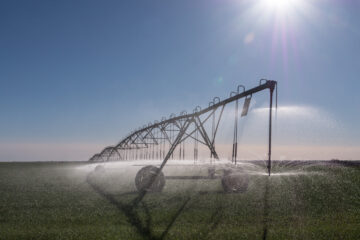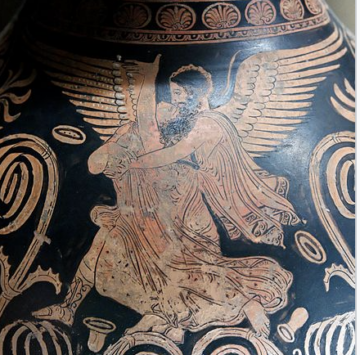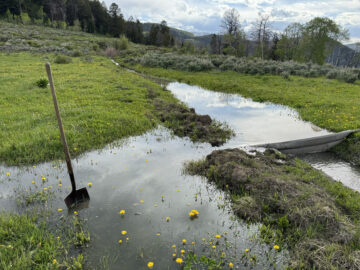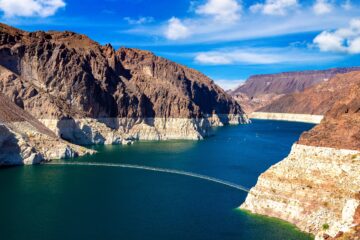by Mark Harvey
Scarcity of water brings out the evil propensities in men quicker than anything else. —Greeley Tribune, July 1, 1874

The summer of 1874 was a particularly dry year in Colorado, and the drought led to a water war between the fledgling towns of Fort Collins and Greeley. In the previous years, Greeley farmers had built extensive irrigation canals off the Poudre River to irrigate crops and had enjoyed abundant water from spring snowmelt.
Fort Collins, still just a small colony, saw the success of its downstream neighbors and decided to build their own irrigation canals off the Poudre as well. So in the summer of 1874, when the farmers near Fort Collins began heavy draws on the Poudre, the downstream Greeley farmers watched their crops begin to wither and die. They wouldn’t take it lying down.
As the summer advanced and the streams were reduced, the Greeley farmers became desperate for water. They sent men upstream to explore the Fort Collins ditches and concluded that their neighbors were wasting precious water and outright stealing what belonged to them. After some legal threats, the parties agreed to meet at a schoolhouse in the town of Eaton, halfway between Greeley and Fort Collins. They hoped to find a way forward in a situation where there just wasn’t enough water for the ambitions of the two towns.
Despite lengthy discussions, legal arguments about prior appropriation, and threats, in the words of water historian George Sibley, “the only successful outcome was that no one was shot.”
Meanwhile, in the same summer of 1874, further south in the Arkansas River Valley near what is today the town of Salida, a war broke out between two ranchers fighting over an irrigation ditch. George Harrington and Elijah Gibbs, both ranchers, had been arguing over ditch rights near Gas Creek for several weeks when their arguments turned to violence. On the morning of June 17, 1874, Harrington noticed that one of his outbuildings was set ablaze. He and his wife hurried to put the fire out, and when he left his house, he was shot in the back and killed immediately.
Harrington’s friends and family were convinced that Gibbs had done the killing over the ditch dispute and attacked Gibbs’s house on January 22, 1875. Gibbs held his own in a violent gunfight that took the lives of two more men. But he and his family left the valley shortly thereafter as vigilantes continued to harass his family, and friends. Over the next seven years, the so-called Lake County Water Wars continued with threats, lynchings, men tortured, and arson. The war took the lives of between 10 and 100 men, depending on the account.
So just a few years after the Colorado Territory 1859 gold rush, and even before becoming a state in 1876, farmers and city folk began fighting over scarce water in an arid land. It was so evident to the first Colorado legislators of 1876 that water would determine the state’s destiny that they included water doctrine in the constitution. Article XVI of the original Colorado constitution outlines the concept of water as a public entity, the concept of beneficial use, the law of prior appropriation, and the right of way to build ditches and canals across private properties.
These concepts outlined in the constitution became known as The Colorado Doctrine and the earliest model of prior appropriation. Soon variations of the Colorado Doctrine were adopted by most of the other arid western states.
But the water wars didn’t end then, and they continue to this day in Colorado. They may not be as violent, but they have much of the same intensity, fought now with expensive, high-powered lawyers and skilled engineers.
Here on the Western Slope of Colorado, citizens battle to keep more water from being diverted through massive tunnels to the Front Range to supply the cities of Denver, Pueblo, and Colorado Springs. And they play the delicate chess game of water allocation and diversions as they negotiate the complicated Colorado Compact.
And citizens fight among themselves over ditches, tributaries, ponds, springs, and reservoirs. Ranchers in the high country want the water to pasture cattle and grow hay, farmers downstream need it for peach orchards and vineyards, environmentalists and anglers strive to keep some water left in natural riverbeds for the fish, birds, and riparian habitat, and towns and cities want it for newly built neighborhoods and golf courses.
Between seventy and eighty percent of Colorado’s water comes from melting snow. So much of what we’re able to accomplish in the spring and summer is determined during the dark, cold days of winter.

The Greek God of winter was Boreas, a strong man with a violent temper who abducted his lover and somehow fathered 12 horses with the mares of King Erichthonius. In some cases, he is portrayed as an old man, which might be where the term Old Man Winter comes from. Old Man Winter is not a kind old man in Colorado’s high country. In October, he teases us with an early snow that usually melts quickly and allows for a few more glittering days of clear skies and cool fall weather.
Then in November the skies darken, and the heavy snows come. From November through early April, we are beholden to icy roads and chained to the shovel and the snowplow. All winter the mountains accumulate vast amounts of snow that will melt in the spring and make its way in streams and rivers to Utah, Arizona, Nevada, and California.
I think of the snowpack as a giant savings account for farmers and ranchers. Like a frugal pensioner, Old Man Winter builds that account right up through early April, and then Helios, the god of the sun, and Persephone, the goddess of spring, burn through the entire savings in a few short months. I’ll take Persephone over Boreas any day as I love the spring and loathe the winter. But it’s the vast snowpack—which doesn’t usually peak until early April—that allows us our glorious Colorado spring and summer and keeps millions of people fed through the power of irrigation water.

Irrigation is the one job on our ranch that never gets old to me. Granted, we have a short 10-week irrigation season, relying entirely on spring snowmelt, but moving millions of gallons of water across large meadows with just a shovel and a little gravity gives a person a sense of agency and satisfaction not easily found in modern American life. To grow just about anything besides Canada thistle west of the 100th meridian requires irrigation of some sort. Consequently, much of the water in the arid west is adjudicated, litigated, mediated, and equivocated. While the joy of irrigation is unadulterated, the business of attaining and protecting water rights is a bare-knuckled business with tough lawyers and clever engineers. Not for the wet-behind-the-ears.
Just a few words in the Colorado Constitution have radically shaped the state. Section 6 of Article 15 reads: The right to divert the unappropriated waters of any natural stream to beneficial uses shall never be denied. Those eighteen words have led to billions of dollars of water-related construction, billions of dollars of litigation, some horrendous environmental consequences, and billions of dollars of agricultural production. In water disputes, not much is black and white; mostly it’s green, the color of money. In fact, there’s a saying that in the west, water flows uphill toward money. In some cases with massive trans-basin diversion projects, water literally does flow uphill under the power of immense siphons and pumps.

There is evidence that some 8,000 years before, Coloradans were going all agro and turning to their guns over water fights, and people were irrigating in the Jordan Valley. The Minoans on the island of Crete built beautiful irrigation structures, cisterns, and settling tanks four thousand years ago. Some of the most beautiful structures I’ve ever seen (in photos) are related to water storage. Take the Basilica Cistern for example, built about 1,500 years ago in Turkey. In a vast structure covering more than 100,000 square feet, the emperor Justinian built a cistern thirty feet high with 336 marble columns, intricate carvings and marble arches. The cistern holds 21 million gallons and looks like a beautiful church.
Irrigation is not new and water wars are not new. Close to five thousand years before Greeley and Fort Collins fought over water, the cities of Lagash and Umma fought over the water from the Tigris and Euphrates rivers needed for irrigation in what is today Iraq. The winners of that war, the city of Lagash, even built a small monument celebrating their victory with claims of divine support. There are chards from the monument in the Louvre and it’s remarkable the detailed history assyriologists can interpret from a few pieces of ancient stone. Evidently the water wars in Mesopotamia involved spears, axes, huge arrays of soldiers and lasted generations.
We have our own modern city-state water battles fought over both surface water and hidden aquifers. In the West, the seven states that signed the Colorado Water Compact a hundred years ago have been haggling for years over how to allocate the over-adjudicated Colorado River. The seemingly insurmountable disputes have made the federal government a sort of heavy-handed water referee.
Perhaps the scariest trend in the United States related to water is the rate at which we’re depleting our aquifers all across the country. The New York Times has done a masterful treatment of the failing aquifers in its Uncharted Water Series. The series outlines the rapid depletion of groundwater throughout the United States and particularly that of the Ogallala Aquifer which supports the breadbasket states of Kansas, South Dakota, and Nebraska. Not only do aquifers in arid lands take hundreds if not thousands of years to recharge, the aquifer itself can collapse as water is pumped out. Consequently, the land permanently loses its ability to store subsurface water.
Since a vast amount of the world’s food—corn, wheat, soybeans––is grown from the land fed by the Ogallala, it’s fair to conclude we’ll face food shortages or big increases in food prices in the near future. Farmers using the nation’s vast aquifers are developing techniques and technologies that produce the same amount of food with less water (remote sensing, precision irrigation, cover cropping, etc.), but from my reading, it doesn’t seem to be happening fast enough.

With the megadrought that has plagued the western United States over the last two decades, the water level in Lake Mead (which is the water storage for California, Nevada, and Arizona’s share of the Colorado River) dropped to 27 percent of its carrying capacity in the summer of 2022. As the lake dried up, various human bodies were revealed, some of which were the results of obvious murders. One body was found inside a barrel. The person had been shot and it doesn’t take a forensics expert to conclude it wasn’t suicide. Just as grizzly crimes of the past are resurfacing in the drying lake next to Las Vegas, so is our over-confidence in farming dry lands with scarce water being displayed in sharp relief.
May we not follow the path of ancient Lagash and Umma, leaving only a dusty trace of a civilization. As T.S. Elliot suggests, “If there were only water amongst the rock.“
